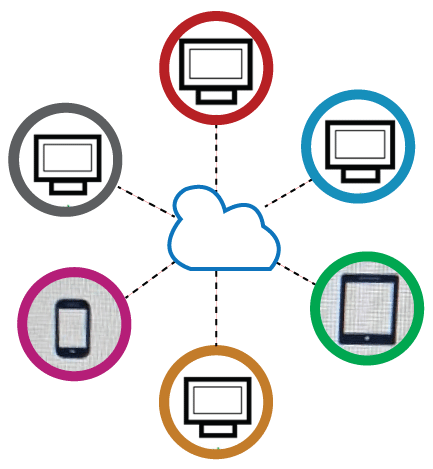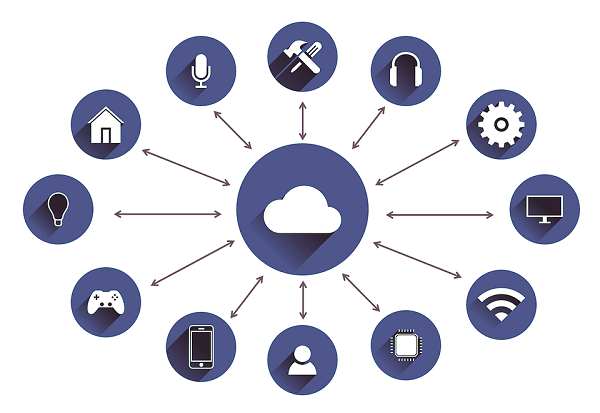Difference between Cloud computing and the Internet of Things?The key difference between Cloud Computing and the Internet of Things is that Cloud Computing provides hosted services over the Internet. In contrast, the Internet of Things connects surrounding smart devices to the network to share and analyze decision-making data. Cloud computing and the Internet of things are modern technology. The acronym for the Internet of Things is IoT. Cloud computing provides the tools and services needed to build IoT applications. Moreover, it helps in achieving efficient and accurate IoT-based applications. What is Cloud Computing?Organizations need time and budget to scale up their IT infrastructure. On-campus, expanding IT infrastructure is difficult and requires more time. Cloud computing provides an optimal solution to this problem. Cloud computing services consist of virtual data centers that provide hardware, software, and resources when needed. Therefore, organizations can directly connect to the cloud and access the required resources. It helps reduce the cost and scale up and down as per the business requirements. 
There are two types of models in cloud computing called the deployment model and service model. Deployment models describe the access type to the cloud. These types are public, private, community and hybrid. First, the public cloud provides services to the general public. Secondly, the private cloud provides services for the organization. Third, the community cloud provides services to a group of organizations. Finally, a hybrid cloud is a combination of public and private clouds. The private cloud performs critical activities in a hybrid while the public performs non-critical activities. IaaS, PaaS, and SaaS are the three service models in cloud computing. Firstly, IaaS stands for Infrastructure as a Service. It provides access to basic resources such as physical machines, virtual machines, and virtual storage. Secondly, PaaS stands for Platform as a Service. It provides a runtime environment for the applications. Lastly, SaaS stands for Software as a Service. It allows end-users to use software applications as a service. Overall, cloud computing offers many advantages. It is highly efficient, reliable, flexible, and cost-effective. It allows applications to access and use resources in the form of utilities. In addition, it provides online development and deployment tools. One drawback is that there can be security and privacy issues. What is the Internet of Things?The Internet of Things connects all nearby smart devices to the network. These devices use sensors and actuators to communicate with each other. Sensors sense surrounding movements while actuators respond to sensory activities. The devices can be a smartphone, smart washing machine, smartwatch, smart TV, smart car, etc. Assume a smart shoe that is connected to the Internet. It can collect data on the number of steps it can run. The smartphone can connect to the Internet and view this data. It analyzes the data and provides the user with the number of calories burned and other fitness advice. 
Another example is a smart traffic camera that can monitor congestion and accidents. It sends data to the gateway. This gateway receives data from that camera as well as other similar cameras. All these connected devices form an intelligent traffic management system. It shares, analyzes, and stores data on the cloud. When an accident occurs, the system analyzes the impact and sends instructions to guide drivers to avoid the accident. Overall, the Internet of Things is an emerging technology, and it will grow rapidly in the future. Similarly, there are many examples in healthcare, manufacturing, energy production, agriculture, etc. One drawback is that there can be security and privacy issues as the devices capture data throughout the day. Which is better, IoT or cloud computing?Over the years, IoT and cloud computing have contributed to implementing many application scenarios such as smart transportation, cities and communities, homes, the environment, and healthcare. Both technologies work to increase efficiency in our everyday tasks. Cloud computing collects data from IoT sensors and calculates it accordingly. Although the two are very different paradigms, they are not contradictory technologies; They complement each other. Difference between the Internet of things and cloud computingMeaning of Internet of things and cloud computing IoT is a network of interconnected devices, machines, vehicles, and other 'things' that can be embedded with sensors, electronics, and software that allows them to collect and interchange data. IoT is a system of interconnected things with unique identifiers and can exchange data over a network with little or no human interaction. Cloud computing allows individuals and businesses to access on-demand computing resources and applications. Internet of Things and Cloud ComputingThe main objective of IoT is to create an ecosystem of interconnected things and give them the ability to sense, touch, control, and communicate with others. The idea is to connect everything and everyone and help us live and work better. IoT provides businesses with real-time insights into everything from everyday operations to the performance of machines and logistics and supply chains. On the other hand, cloud computing helps us make the most of all the data generated by IoT, allowing us to connect with our business from anywhere, whenever we want. Applications of Internet of Things and Cloud ComputingIoT's most important and common applications are smartwatches, fitness trackers, smartphones, smart home appliances, smart cities, automated transportation, smart surveillance, virtual assistants, driverless cars, thermostats, implants, lights, and more. Real-world examples of cloud computing include antivirus applications, online data storage, data analysis, email applications, digital video software, online meeting applications, etc. Internet of Things vs. Cloud Computing: Comparison Chart
SummaryWhile IoT and cloud computing are two different technologies that aim to make our daily lives easier, they are not contradictory technologies; They complement each other. The two work in collaboration to increase efficiency in our daily tasks. The basic concept of IoT is connectivity, in which physical objects or things are connected to the web - from fitness trackers to smart cars and smart home devices. The idea is to connect everything to the Internet and control them from the Internet. Cloud computing helps to manage the IoT infrastructure.
Next TopicWeb Services in Cloud Computing
|
 For Videos Join Our Youtube Channel: Join Now
For Videos Join Our Youtube Channel: Join Now
Feedback
- Send your Feedback to [email protected]
Help Others, Please Share










